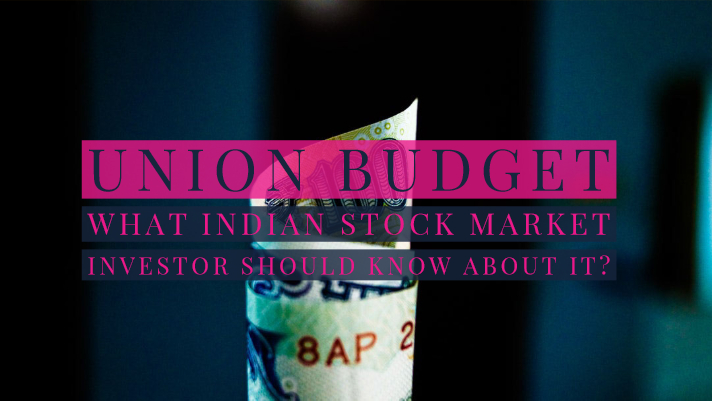Published : January 7, 2019

Union budget is around the corner. Every year, the government announcement of budget sets the tone for the sectoral performance of the economy. In turn, companies revenue get impact from such an announcement. Thus, in short, the union budget does impact retail investor invests in shares. Consequently, knowledge of what is union budget and how union budget works is of prime importance. Especially to the retail investor in India. But before we proceed further in analysing union budget, let us understand “What the union budget in actual is?”
The word budget is derived from the French word, “Bougette”. This means a bag or a wallet. The other name of the budget is the “Annual Financial Statement”. In India, the union budget is the annual financial statement of accounts for the preceding and current year. Besides, it is the estimates of the revenue and expenditure of the coming year.
The constitution of India defines the union budget under the “article 112 of the constitution”. As per article 112, the union budget is –
“A statement of estimated receipts and expenditure of the government of India”.
Every financial year the government presents the budget before the parliament. This statement shows the receipts and payments of the government of India. The government accounts are kept under the three parts –
The Indian budget begins from 1st April and ends on 31st March. The finance ministry frames the budget of the Union Government of India. This we call as “Union Budget”. The general rule is that he who spends the money must also prepare estimates in advance. Hence, disbursing officers of the central government prepare the preliminary estimates. In government, the funds come largely from taxes. Also, they receive borrowings and earnings of public enterprises. Furthermore, these are made available by the legislature through specific appropriations and programmes.
Thus, the union budget is an instrument of parliamentary over the financial activities of government. It indicates how the government raises resources. Moreover, it also contains information on how the government directs them into different channels.
In fact, it represents the fiscal policy of the government. This indicates how public revenue and expenditure intend to affect the level of national income. Along with it, this also suggests the effect of the budget on overall employment generation within the economy. There is also hint on the production and the distribution of incomes and wealth among different sections of the society.
Thus, the study of the budget is of vital importance and is a matter of great concern from an investors point of view too. Now after understanding the concept of union budget let us understand its procedure.
A proper understanding of the procedure of union budget empowers the investors in timing their investments. So, let us know about the budgetary process in little details. Basically, three operations are done for the union budget. I will be discussing them in below paragraphs.
This is the first step. In fact, it is a fact that framing a budget is an art of reconciling the contradictions. Now, suppose there is a demand for tax concession. But at the same time, there are expenditures to enhance the interest among the people around. Remarkably, in such a situation, the most obvious question arises –
“Where will the money come from?”
This is the most practical situation most economies faces across the globe. Consequently, the Indian government starts working on it around the month of November. In India, the finance ministry is answerable to such question. Henceforward, for this, they prepare the budget in four different columns, namely,
(i) Actual expense of the previous year,
(ii) Sanctioning of the estimates for the current year,
(iii) Estimates revision for the current year, and
(iv) Budget estimates for the next year.
Forthwith, the first part of the budget is getting the final touch by the month of January. Straightaway, in this month all the ministry asks for the Blue Sheet. It is a single sheet of paper that shows the broad numbers. Furthermore, it also details on revenue expectations and what is the deficit looks like.
The budget group has core team members. Such core team consists of finance minister, finance, revenue, and expenditure secretary, including the chief economic advisor.
Post this phase the union budget enters the second phase, which I explain below.
Following approval of the appropriation bill and financial bill by both Lok Sabha and Rajya Sabha, the central government initiates raising revenue and incurring expenditure. Meanwhile, they take the following steps –
Execution is the last step in the union budget in India. There are three aspects of the execution of the budget:
The administrative responsibility for the assessment of revenue and collection of revenues lies upon the departments assigned for taxes.
Now after going through the details about the meaning and procedure of union budget in India, let us briefly see the various types of budget.
Indian government budget comprises the following –
It consists of revenue receipts and revenue expenditure of government. Revenue receipt comprises of tax revenue and non-tax revenue. Non-tax revenues include interest and dividends on the investment made by government, fee and other services rendered by the government. Expenditure, which does not result in the creation of the asset is revenue expenditure.
Capital budget consists of capital receipts and capital expenditure or payments. The main items of capital receipts are market loans, borrowings from Reserve Bank of India and other parties. Government do such borrowings through instruments like the sale of treasury bills, loans from foreign governments and bodies and recoveries of the loan to the state and Union Territory.
Capital payments consist of expenditure on acquisition of assets like land, buildings, machinery, equipment, and also the investment in shares, etc., and loans advance by Central to State and Government companies, corporations and other parties.
Budget on the basis of performance is for the volume of work that needs completion during a financial year. Performance budget costs show the performance or the improvement of internal management of the government.
Program budget emphasis the need for overall programmes management. It is in the light of long-term clearly defined objectives. Furthermore, it also involves the choice between alternative programmes based on their cost and benefit implications.
This means the budget as a whole and not to examine incremental change only.
First look at the various types of the deficit in the union budget. There are the following different types of the deficit in budgets –
As a stock market investor the knowledge of the nature and type of union budget deficit is crucial. It gives clues for the further performance of the economy as a whole. If the plan that government lays for overcoming the deficit is workable, it will help recover the economy, say in case of poor GDP growth scenario.
Similarly, the as an investor you must look for the ways that government plans for financing these deficits. It there is anything like increasing tax on corporates, its a negative sign for the stock market. As this will eat up substantial profitability of the companies. So keeping track of the deficit of budget will definitely help investors in adjusting their own stock portfolio.
All the accounting information relating to the government of India is there in the union budget. The sources of income and the government proposal to spend all the monies are there in the budget. The income and the sources of income constitute revenue. While all that government plan to spent comes under expenditure heading.
These revenue and expenditure accounting is, in fact, a proxy for the outlook of the economy. Whether the economy is going to contract or expand, you can easily judge while looking at them. So, let us look in some details on the revenue and expenditure of the government.
These are the source of income that the government realizes and are –
All government spendings are put into two subheadings. Plan expenditure and non-plan expenditures. Let us understand them properly.
Economic planning is a strategy of economic development in India. To see the growth in the rate of economic development, five years plan has been formulated. These are five-year plan expenditures by the central government. It is further classified into –
(a) Revenue expenditure – These are the payments usually done for day to day ongoing of government departments. Also, expenses on the services to the citizens are part of it. For instance, spending on subsidies, interest payments are revenue expenditures.
(b) Capital expenditure – These kinds of expenditure customarily stimulates asset creation. Consequently, it results in inflation. As because of investment by spending redirect costs. Such cost usually associates with the acquisition of assets. These further include the investment of shares, infrastructure as well as loans and advances given out by the government.
It includes both developmental and non-developmental expenditure. Non-plan expenditures are ongoing expenditures of government excluding five-year plans expenditures.
(a) Non plan revenue expenditure – It will be deemed as subsidies (mainly food and fertilizers), interest payments, wage and salary payments to government employees, grants to states and Union Territories governments, pensions, police, economic services in various sectors, other general services such as tax collection, social services, and grants to foreign governments.
(b) Non-plan capital expenditure – It includes Union Territories and foreign governments, loans to public enterprises, loans to states, defence.
See if a government functions properly, it means a lot to the stock market. A stable and progressive government at centre casts a very positive impact on stock market performance. With this mind, it worth considering how the government plans for fueling economic growth.
For instance, an increase in expenditure that creates infrastructure will result in a bullish tone in the stock market. However, unusual spending on social welfare schemes with high taxing on corporates will take stock market down. So, you need to keep a proper track on government income and spending.
Therefore, even before you plan to initiate your stock market journey, it is advisable to start digging into how the government manages the economy. Hence, a deep understanding of governments yearly revenue and expenditures is of prime importance for you as an investor.
These are the money that the government borrows. It is eventually a burden on the people of India. Hence, we call it public debt. It includes items such as market loans, special bearer bonds, treasury bills, and special loans and securities issued by the Reserve Bank. These are the internal borrowings of the country. On the other hand, the government may also borrow funds from non-Indian sources. These equal external borrowings.
Whenever public expenditure exceeds public revenue, it is not necessary that the tax system would get affected. The important part that has to keep a check on is whether the transactions are casual or regular. In case of a casual budget deficit, to overcome the deficit, one can raise loans. Instead, if the deficit has a regular feature over the years, then the proper course for the state would be to raise further revenue by taxation or reduce its expenditure.
Any increase in public debt for meeting any casual government expenditure does not have a negative impact on the stock market. However, if there is an increase due to meeting regular kind of expenses, then its a cause of concern for the stock market.
The expenditure on government is generally more than what it earns. This shortfall is the fiscal deficit. The government meets this with borrowing funds. Thus, the fiscal deficit is the difference between total revenue and total expenditure of the government. It is the need of total borrowings for the government.
Technically, the gross fiscal deficit is the excess of total expenditure including loans net of recovery over revenue receipts and non- debt capital receipts. Thus, the fiscal deficit is the gross fiscal deficit less net lending of the central government. In other words, it is the excess of government expenditure over ‘non-borrow receipts’.
Generally, fiscal deficit takes place either due to revenue deficit or a major hike in capital expenditure. In general capital expenditure incurs to create long-term assets. Assets such as factories, buildings, and other developments.
The government may adopt any of the two ways to finance its deficit. Either through borrowing from either the central bank of the country. Or by raising money from capital markets by issuing different instruments like treasury bills and bonds.
This would in futures definitely benefit the investors involved in various investment plan because they can expect more return due to increase in funds in capital markets and at the same time they would have to pay more for their investment.
Excess of revenue expenditure over revenue receipts is revenue deficit. It is a result of a discrepancy between expected revenue and expenditure. This deficit arises when the government’s actual net receipts are lower than projected receipts. Whereas, if the actual receipt is higher than the government projection, this become revenue surplus. One should know that revenue receipt does not mean the actual loss of revenue.
We can take an example here to understand this. Suppose government spends INR 100 and earns INR 125, the net revenue is INR 25. However, if the government expenditure estimates at INR 100 and earning go up to INR 130. In such case, its revenue expectations became INR 30. But since the actual earning is INR 25, then it would lead to a revenue deficit of INR 5 (expected Revenue INR 30 – Achieved Revenue INR 25)
There is a situation when all expenditure on revenue matches from receipts on revenue account. In such a case, the revenue deficit becomes zero. In such a situation, the government borrowing will not be for consumption but for the creation of assets.
Ideally, a zero revenue deficit is good for the stock market. Both revenue deficit and surplus put a negative effect on the stock market investments. In a situation of surplus, implies some flaws in the government projections. This may lead to further easing out social welfare schemes at the cost of excess revenue. Similarly, a deficit might suggest for poor government planning.
Primary deficit is the fiscal deficit less the interest payment by the government on its earlier borrowings. For further understanding, the scenario let us consider this. The money that the government pays to its creditors as interest naturally forms part of the total government’s expenditure.
However, like other schemes, it is not an intentional initiation of the government. So the amount should ideally not form the part of entire spending made by the government for developmental works.
Lower primary deficit means less interest payment and gives a positive signal to the stock market. A larger primary deficit, on the other hand, put additional pressure on the government to generate additional revenue to service the interest burden. hence, negative for the stock market.
This is an even tighter number than the revenue deficit. Effective revenue deficit is the difference between revenue deficit and grants for the creation of capital assets. In other words, the effective revenue deficit excludes revenue expenditures in the form of grants for capital assets creation.
Effective revenue deficit came into existence from the budget of 2011- 12 in India. In 2012- 13 it becomes live as the fiscal parameter. This helps to cure the distortions caused by large-scale transfers to other entities.
Low level of effective revenue deficit over years is positive for stock market players. As this excludes all such expense that is meant for asset creation. Asset creation is a positive step from stock market investments.
Apart from numbers in rupees, the budget document also mentions deficit as a percentage of GDP. This is because, in absolute terms, the fiscal deficit may be large. But when it is small in comparison to the size of the economy, then it’s not such a bad thing. For instance when fiscal deficit results in creating production capacities of the economy.
The findings of few studies indicate that a one per cent increase in deficit can lead to a decrease in GDP by 0.618609. This means that there is a negative relationship between GDP and deficit in the long run. The deficit can hamper the economic growth in the long run and hence the gap between government revenue and government expenditure should be minimized.
Hereby, I conclude by saying that any investors planning to invest should always keep an eye on the union budget. Because one should have an idea of how the prices of stock, shares, bonds, etc., will get affected by the budget plan. The knowledge of various deficit is also very important. It shows the actual picture of the market about how it is going to be in the upcoming financial year.

Enjoy flexible trading limits at
lowest brokerage rates ?
Open Your Investments Account Now
0Account Opening Charges
Life Time Demat AMC
Brokerage








IT'S TIME TO HAVE SOME FUN!
Your family deserves this time more than we do.
Share happiness with your family today & come back soon. We will be right here.
Investment to ek bahana hai,
humein to khushiyon ko badhana hai.
E-mail
askus@rmoneyindia.com
Customer Care
+91-9568654321